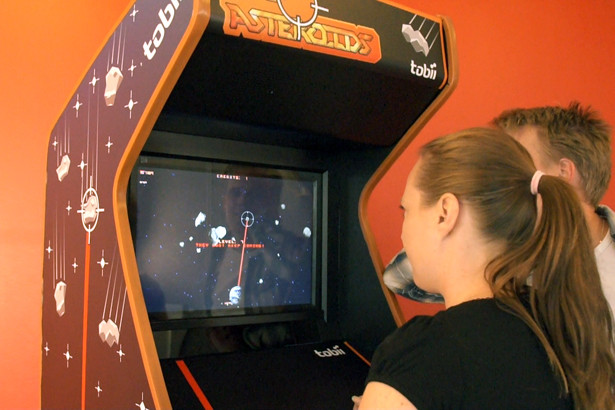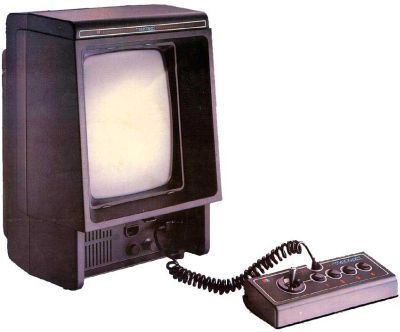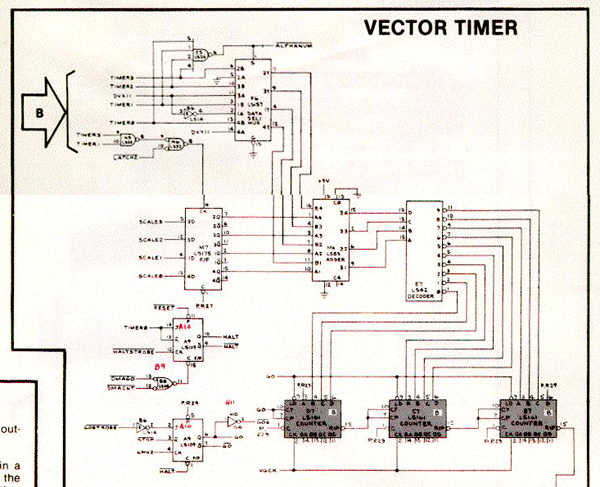Bruce Glick Prepares for 48-Hours of Asteroids
Posted on January 17, 2013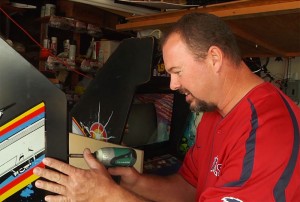 On Friday, February 8, 2013, at 7:00 pm PST, Bruce Glick begins his uninterrupted 48-hour session of Atari Asteroids at Mama’s on 39 in Huntington Beach, California, also streaming live on Twitch.
On Friday, February 8, 2013, at 7:00 pm PST, Bruce Glick begins his uninterrupted 48-hour session of Atari Asteroids at Mama’s on 39 in Huntington Beach, California, also streaming live on Twitch.
Glick is working up to a world-record attempt. He’s got his eye on John McAllister’s 2010 high score of 41,838,740, although beating it won’t be an easy feat. Before that, Asteroids was the longest-standing unbeaten arcade game record, set in 1982 by Scott Safran.
But Glick isn’t just doing this for personal glory. He’s doing it for the kids. We spoke with him to find out more.
Atari Asteroids: How did you first come up with the idea for this marathon session?
Bruce Glick: I guess it was just a natural progression. I needed to do something in a live setting and I want the experience before I make the attempt at the record.
AA: Why is a live setting important?
BG: It’s the way Scott Safran did it back in the day, and that’s how it should be done now. Too many people are doing these exclusively on the internet. Takes the coolness out of it. Plus there’s way more pressure.
AA: Last year, you completed a 36-hour-straight session where you scored 18,000,000. What was that like?
BG: It was awesome! Never attempted anything like this before. All my neighbors and some friends came over at different intervals to watch and cheer me on.
AA: How have you been preparing for this upcoming 48-hour session?
BG: My actual game play is sporadic due to my heavy work load. When I do play it’s more for an hour or two at a time, working on technique and reflex. My real training has come in the form of exercise for physical health. I felt this was extremely important for me. I was definitely overweight and not in the best shape. I am proud to say since October 30th I’ve lost 40 lbs and exercise regularly.
AA: I hear you’ve gotten involved with the McKenna Claire Foundation for this event.
BG: The McKenna Claire Foundation raises money for pediatric brain cancer research. I figured if I’m going to do something that’s going to attract attention and people will be watching, then I might as well make it worth-while. They have made a huge impact in our town, and it’s for a great cause.
I met with Dave and Kristine Wetzel [the foundation’s Co-Founders and McKenna’s parents], and they were nice enough to give my wife and me a jacket with the MCF logo on it. I will be wearing it in the morning during my runs. It is very inspiring to me.
AA: It sounds like kids’ health is very important to you.
BG: Yes, it’s the future of our country. “The Biggest Loser†has really touched on the subject this season. The fact that video games are being blamed for a large portion of the epidemic doesn’t sit well with me. I know it defiantly plays a part in it.
I want to show kids that doing something like a 48-hour marathon actually takes physical training and good health to achieve. Kids shouldn’t spend countless hours gaming. Even when I was a kid and we had our Atari 2600 and our local arcade we still rode bikes, skateboards, built forts. We did stuff.
AA: You have your own Asteroids machine. What other arcade games do you own?
BG: I currently have two Asteroids machines, Gauntlet 2, Galaxian, Missile Command, and a MAME system (Multi Arcade Machine Emulator). It has pretty much every game you can think of plus all the ones you forgot about.
AA: What do you look for in an Asteroids machine, for an event like this?
BG: I just play it and if she’s smooth it’s good. These games are so old they’re either in good condition or they’re not. One thing to consider is the PCB basically the heart of the game. If the PCB looks good no cracks in the solder, no blistering of capacitors or burn spots any where then it’s probably good. It’s really just luck to get one that works well.
The machine that I will be doing my 48-hour on is the biggest piece of crap ever. Seriously it’s embarrassing how messed up it is. The reason I play it is because its internals are nice. It’s basically the Millennium Falcon.
AA: So what can people expect on February 8-10? If they’re in the area, can they stop by Mama’s?
BG: Yes, yes! It’s open to the public — it’s a live forum. I will have all my games down there for people to play so anybody, even McAllister, could roll up and go head to head with me. Mama’s has great service, food, and atmosphere. They have a nice bar and big screens for watching your favorite sporting event. Anybody is welcome to walk up and talk to me. I may not be able to make good eye contact but I will definitely be able to answer any questions anybody has or just talk about whatever.
I don’t know if McAllister has seen your site or knows anything about me, but it sure would be cool if he was in the area that weekend. I would love to meet that guy. He is a legend in the vintage video game world, and if anybody doesn’t know, the current world record holder.
AA: Is there anything else you’d like to add?
BG: Just for the record I’m not looking for personal notoriety. I just want to raise money for the foundation and play my game. It’s really not about me — it’s about everyone else involved. Without all the great people that have been helping me I wouldn’t be answering these questions or doing the 48-hour at Mama’s. Generating interest in vintage games is always cool though.
Links:
Tobii Technology Builds Eye-Controlled Asteroids Cabinet!
Posted on November 06, 2011Tobii Technology has built a one-off Asteroids arcade cabinet, designed to showcase their eye-tracking technology. Â The game made its premiere at CeBIT in March, to demo eye-tracking on laptops. Â This is another step towards more natural human-machine interaction, and according to Tobii, much faster than hitting buttons or full-body motion sensors.
The full arcade version of Eye-Asteroids makes its debut on Tuesday, November 8, 2011, at the Dave and Buster’s in Times Square, New York, before heading off on a world tour. Â Known stops are London in late-November, and Las Vegas at CES next year.
The game is much closer to Missile Command than Asteroids, as you protect Earth from incoming ELEs (Extinction Level Events) by blasting them with lasers with your eyes. Â They could have used this technology to create Superman-Meets-Big-Buck-Hunter, but we approve of their choice.
The game’s debut corresponds with Tuesday’s near-Earth encounter with a real asteroid, that will pass by closer than the moon. Â Read about that here.
We’ll stop by Dave and Busters for a full review. Â Check back for that!
Engadget’s coverage of Tobii at CeBIT (includes video):
http://www.engadget.com/2011/03/01/tobii-and-lenovo-show-off-prototype-eye-controlled-laptop-we-go/
Pocket-lint’s report of Eye Asteroids:
http://www.pocket-lint.com/news/42895/tobii-eyeasteroids-arcade-machine-eye-controls
Tobii’s Site:
http://www.tobii.com/
Portable Vector Arcade: The Vectrex
Posted on June 27, 2011Much of arcade Asteroids’s allure is the glowing, minimalist vector screen. Instead of a standard TV monitor, which scans from top to bottom over and over again, the vector display draws straight lines from one point to the next where needed, like an oscilloscope. It can only be a simple polygon outline of one color, but it also means that the image is sharp and bright (Asteroids’s photon torpedoes leave a brilliant trace along the slowly-decaying phosphor of the screen), and simple to program (the video and sound data in the arcade version of Asteroids is just 2 KB of ROM code, and the game program is another 6 KB). It’s why we have the Asteroids locator on this site: to this day, no home version or variation of Asteroids really does the same thing.
Except one.
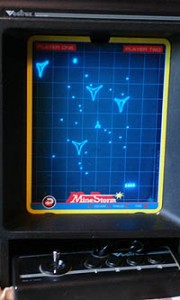 Enter the Vectrex. In 1982, Western Technologies/Smith Engineering developed a home video game device with an actual vector display — the only one of its kind, ever. The Vectrex was released by General Consumer Electric (GCE), then bought by Milton Bradley, at the end of 1982. Its big selling point was that unlike the Atari 2600, it was a stand-alone system that didn’t tie up the television. Timing was bad, though with a glut of home video game systems hitting the market at the same time, leading to the North American Video Game Crash of 1983. One year after it hit the shelves, production for the Vectrex was discontinued, and in another year, the commercial life of the Vectrex was over.
Enter the Vectrex. In 1982, Western Technologies/Smith Engineering developed a home video game device with an actual vector display — the only one of its kind, ever. The Vectrex was released by General Consumer Electric (GCE), then bought by Milton Bradley, at the end of 1982. Its big selling point was that unlike the Atari 2600, it was a stand-alone system that didn’t tie up the television. Timing was bad, though with a glut of home video game systems hitting the market at the same time, leading to the North American Video Game Crash of 1983. One year after it hit the shelves, production for the Vectrex was discontinued, and in another year, the commercial life of the Vectrex was over.
The Vectrex came with one game built in: Mine Storm, which is like Asteroids, but with mines. The official story is this:
Tread lightly! The transport lanes of intergalactic space have been seeded with mines from an alien vessel. Use your mine destroying blaster to blow up the mines before they annihilate you! You may survive the floating mines, but beware of the fireball, magnetic, and treacherous fireball- magnetic mines… 13 fields, each one more difficult, await you!
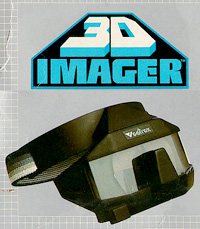 A few years ago, Indie 3D filmmaker and DIY stereoscopic expert Eric Kurland invited me to his Secret Underground Lair in Echo Park, LA, which is filled with all sorts of 3D goodies, including a pristene Vectrex. Yes, not only does the Vectrex have a true vector screen — several of the games are in 3D! Its giant (optional) headset operates much like a lot of home 3D glasses today, alternately blocking the left and right eyes very rapidly, in sync with the display showing the left then right image. Among these games is a 3D version of Mine Storm.
A few years ago, Indie 3D filmmaker and DIY stereoscopic expert Eric Kurland invited me to his Secret Underground Lair in Echo Park, LA, which is filled with all sorts of 3D goodies, including a pristene Vectrex. Yes, not only does the Vectrex have a true vector screen — several of the games are in 3D! Its giant (optional) headset operates much like a lot of home 3D glasses today, alternately blocking the left and right eyes very rapidly, in sync with the display showing the left then right image. Among these games is a 3D version of Mine Storm.
It was pretty cool.
The game action wasn’t actually in 3D, but some of the mines looked closer to you than other ones.
 Being such a unique and awesome device, the Vectrex has a following to this day. The Vectrex Museum website is a great resource for all things Vectrex, and is a site after our own heart. Be sure to check out their intro video, which includes an introduction from the excellent video How to Beat Home Video Games (1982), as well as clips of modern users like chiptune musician little-scale.
Being such a unique and awesome device, the Vectrex has a following to this day. The Vectrex Museum website is a great resource for all things Vectrex, and is a site after our own heart. Be sure to check out their intro video, which includes an introduction from the excellent video How to Beat Home Video Games (1982), as well as clips of modern users like chiptune musician little-scale.
AtariAsteroids.net will be posting more about Vectrex down the road, in our continuing coverage of Things That Are Awesome Like Asteroids. Stay tuned.
Technical goldmine
Posted on June 09, 2009Wonder what’s inside the Asteroids cabinet? Know what’s inside and need to fix it? Do arcane arcade schematics make you drool? Ionpool.net is a comprehensive site of technical information for arcade consoles.
Their Asteroids offerings include a great technical troubleshooting encyclopedia, some Cocktail Asteroids goodies, a patch to operate in an Asteroids Deluxe cabinet, and photos of Arch Maclean’s cabinet restoration.
And if you want to go nuts with schematics, textfiles.com has pdfs of official service manuals.
